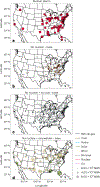Nuclear power generation phase-outs redistribute US air quality and climate-related mortality risk
- PMID: 39360032
- PMCID: PMC11446505
- DOI: 10.1038/s41560-023-01241-8
Nuclear power generation phase-outs redistribute US air quality and climate-related mortality risk
Abstract
We explore how nuclear shut-downs in the United States could affect air pollution, climate and health with existing and alternative grid infrastructure. We develop a dispatch model to estimate emissions of CO2, NO x and SO2 from each electricity-generating unit, feeding these emissions into a chemical transport model to calculate effects on ground-level ozone and fine particulate matter (PM2.5). Our scenario of removing nuclear power results in compensation by coal, gas and oil, resulting in increases in PM2.5 and ozone that lead to an extra 5,200 annual mortalities. Changes in CO2 emissions lead to an order of magnitude higher mortalities throughout the twenty-first century, incurring US$11-180 billion of damages from 1 year of emissions. A scenario exploring simultaneous closures of nuclear and coal plants redistributes health impacts and a scenario with increased penetration of renewables reduces health impacts. Inequities in exposure to pollution are persistent across all scenarios-Black or African American people are exposed to the highest relative levels of pollution.
Conflict of interest statement
Competing interests The authors declare no competing interests.
Figures






Similar articles
-
Air-quality-related health impacts from climate change and from adaptation of cooling demand for buildings in the eastern United States: An interdisciplinary modeling study.PLoS Med. 2018 Jul 3;15(7):e1002599. doi: 10.1371/journal.pmed.1002599. eCollection 2018 Jul. PLoS Med. 2018. PMID: 29969461 Free PMC article.
-
Air quality and health benefits from potential coal power plant closures in Texas.J Air Waste Manag Assoc. 2019 Mar;69(3):333-350. doi: 10.1080/10962247.2018.1537984. Epub 2019 Jan 24. J Air Waste Manag Assoc. 2019. PMID: 30339492
-
Estimating State-Specific Contributions to PM2.5- and O3-Related Health Burden from Residential Combustion and Electricity Generating Unit Emissions in the United States.Environ Health Perspect. 2017 Mar;125(3):324-332. doi: 10.1289/EHP550. Epub 2016 Sep 2. Environ Health Perspect. 2017. PMID: 27586513 Free PMC article.
-
The Minderoo-Monaco Commission on Plastics and Human Health.Ann Glob Health. 2023 Mar 21;89(1):23. doi: 10.5334/aogh.4056. eCollection 2023. Ann Glob Health. 2023. PMID: 36969097 Free PMC article. Review.
-
Climate change impacts on human health over Europe through its effect on air quality.Environ Health. 2017 Dec 5;16(Suppl 1):118. doi: 10.1186/s12940-017-0325-2. Environ Health. 2017. PMID: 29219103 Free PMC article. Review.
References
-
- Annual Energy Outlook 2021 with Projections to 2050 (EIA, 2021).
-
- Larson E et al. Net-Zero America: Potential Pathways, Infrastructure, and Impacts (Princeton Univ., 2021); https://netzeroamerica.princeton.edu/the-report
-
- Markandya A & Wilkinson P Electricity generation and health. Lancet 370, 979–990 (2007). - PubMed
-
- Fell H, Gilbert A, Jenkins JD & Mildenberger M Nuclear power and renewable energy are both associated with national decarbonization. Nat. Energy 7, 25–29 (2022).
-
- Kharecha PA & Hansen JE Prevented mortality and greenhouse gas emissions from historical and projected nuclear power. Environ. Sci. Technol. 47, 4889–4895 (2013). - PubMed
Grants and funding
LinkOut - more resources
Full Text Sources
